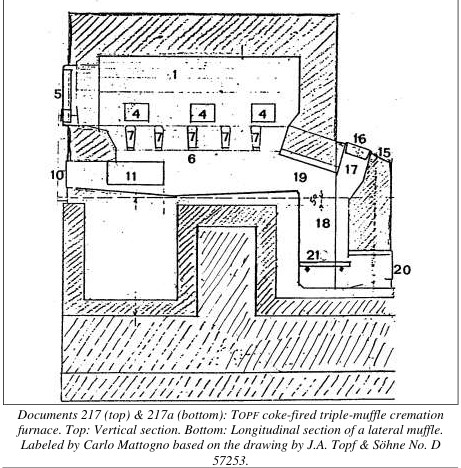bombsaway wrote: ↑Tue Apr 08, 2025 12:40 amCan you put it in your own words? Present the argument of why it's a clear maximum for Birkenau, or at least provide all the relevant quotations from Mattogno (this would include his analysis plus any documents he's relying on).
Imagine if instead of making arguments I was just like look at this HC blog post, it will explain everything. This is a discussion forum.
Apparently no one likes Mattogno! Here's the argument. Cremation capacity is limited by coke throughput, and coke throughput is established by these three sources:
Jahrling: 35 kg/hr/hearth
Colombo: 36 kg/hr/hearth
Kessler: 33.3 kg/hr/hearth
On Rudolf Jahrling, Mattogno writes this on p.375ff:
The Aktenvermerk (file memo) of 17 March 1943, written by the civilian employee Jährling and established “according to data supplied by Topf & Söhne” contains an estimate of the coke consumption of the four Birkenau Crematoria... The heading “10 Feuerungen = 350 kg/stdl.” (10 hearths = 350 kg/hr) means that the five triple-muffle furnaces located in each of the Crematoria II and III had a total of 10 gasifier hearths, two per furnace, each with a grate throughput rate of 35 kg/hr of coke, just as the 8-muffle furnaces of Crematoria IV and V had four hearths each, each one with a throughput of 35 kg of coke per hour.
A 1926 engineering handbook is referenced on p.303:
According to the Colombo Engineering Handbook, the throughput of a hearth grate under natural draft is about 90 to 120 kg of coal per hour per square meter (Colombo 1926, p. 398).
Mattogno explains that the triple-muffle furnaces had a surface area of 0.3 square meters, which works out to 36 kg/hr for the high estimate. The handbook also informs us that forced draft could increase the throughput by up to 50%, however Birkenau did not use forced draft devices.
Mattogno describes Richard Kessler's experiments beginning on p.65. In short, there was a controversy in the cremation industry over what was economical and efficient, so scientific experiments were needed. Kessler separately tested natural gas, coke, and coke briquettes. On p.67 Mattogno describes the total coke usage:
a total of 9.14 Zentner (457 kg) of which, as we have seen, 0.42 Zentner remained unconsumed, so that the total effective consumption amounts to 436 kg.
Then on p.377 he casually divides 457 "by the total operating time of the furnace (13 hours and 42 minutes)", to reach 33.3 kg/hr. You might say he should have used the 436 kg figure instead, but this wouldn't help your case.
One thing you may be confused about is how coke was loaded. This is what the oven looked like. Coke was added at the hatch at no.16, and it rested on the grate at no.21.

- Crema II drawing.jpg (82.73 KiB) Viewed 1284 times
You said that you could "add more fuel to maintain the internal temperature." Certainly fuel was added, but it doesn't follow that just because the fuel was piled higher it would burn more quickly. Imagine for a moment what the implications of that would be. The operator would have to take special care not to overload the shaft, because any overload would waste coke and overheat the oven, but he would also have to constantly load more coke nuggets in to maintain peak efficiency. That doesn't make sense. While I'm unfamiliar with the physics behind this, it's obvious that there must have been some limiting factor to the fire, so I will trust that the area of the grate was the limiting factor here.
It should also just be common sense that if you want to cremate many bodies, then you want to maximize heat energy, so the first thing you would want is a fire bigger than 0.3 square meters. So they should have built accordingly. The fact that they didn't suggests 1 body/muffle was always the intent. Or if burning multiple bodies concurrently was as simple as piling more fuel in the shaft, someone should have figured that out earlier so they didn't have to build so many ovens.